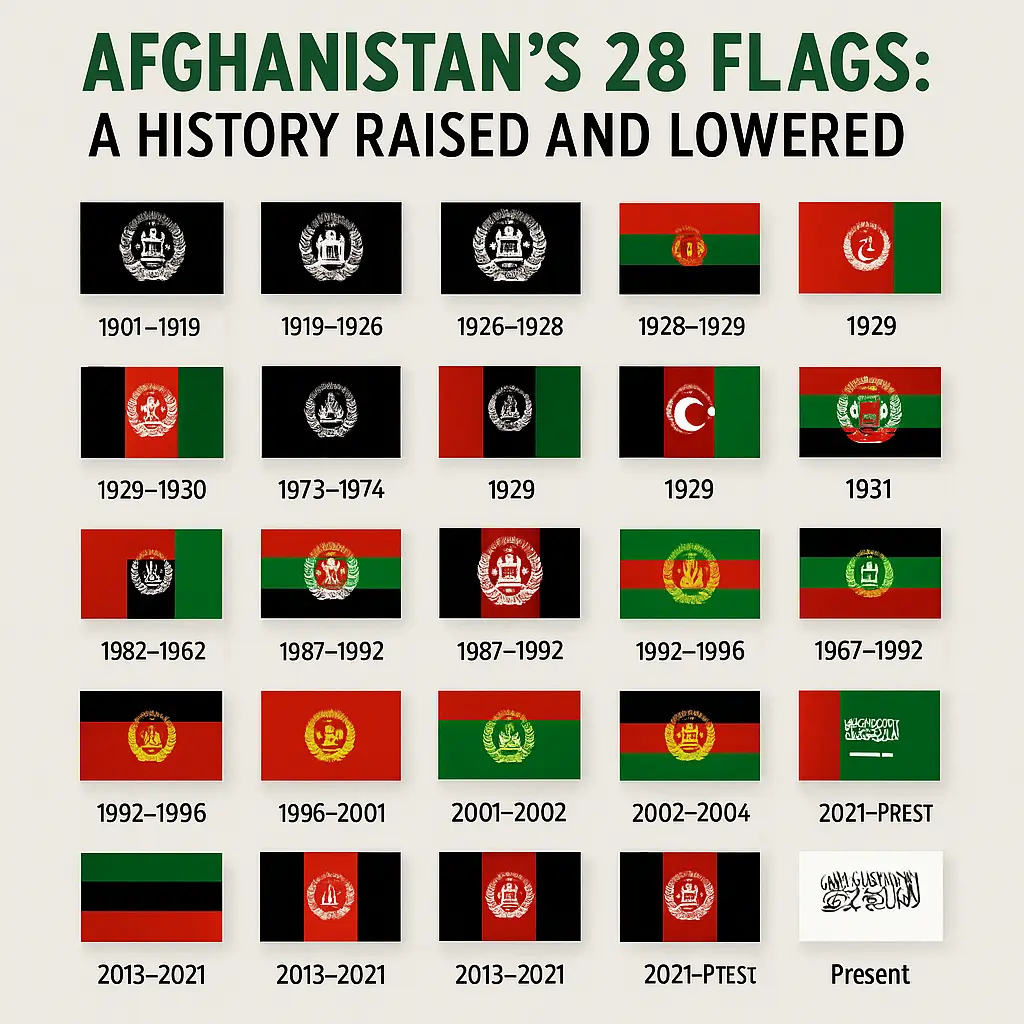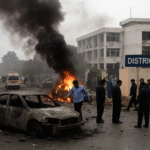How Afghanistan’s flags chronicle a turbulent history of regime shifts, invasions, and shattered sovereignties
Afghanistan holds a tragic distinction: it has changed its national flag 28 times in just over 120 years, more than any other country on Earth. From monarchs to communists, from jihadists to foreign occupiers, and most recently the Taliban, each new regime has introduced a new flag — a new identity — and a new claim to legitimacy.
In many nations, a flag is a symbol of continuity. In Afghanistan, it’s the opposite — a reflection of insecurity, conquest, and deep internal fractures. Every color, symbol, and script change has signaled a shift in ideology, leadership, and vision for the state.
This article explores:
•The timeline of Afghanistan’s regime changes and their flags
•The political upheavals behind each shift
•The meaning behind the designs
•And what this revolving-door of flags says about Afghan sovereignty
🕰️ Timeline: Who Ruled and What Flew (1901–2025)
Period
Regime
Ruling Power
1901–1919
Emirate
Amir Habibullah Khan
1919–1926
Emirate
Amanullah Khan
1926–1929
Kingdom
King Amanullah
1929
Emirate
Habibullah Kalakani
1929–1931
Kingdom
Nadir Shah
1931–1973
Kingdom
Zahir Shah
1973–1978
Republic
Daoud Khan
1978–1992
Communist
PDPA (Soviet-backed)
1992–1996
Islamic State
Mujahideen
1996–2001
Islamic Emirate
Taliban
2001–2021
Islamic Republic
Karzai → Ghani
2021–Present
Islamic Emirate
Taliban
Afghanistan’s flags changed every time a new power seized control — often violently. From monarchies to communism, from Islamic rule to republics and back again, the flag became a visual announcement of conquest or collapse.
🔢 Counting the Chaos: 16 Major Regime Changes
Although there are 28 flags, not every new flag resulted from conquest. Some were design tweaks. However, at least 16 of them coincided with major political upheavals, often involving:
•Foreign invasions
•Coups d’état
•Civil wars
•Systemic ideological changes
These include:
•1929: Kalakani’s rebel rule
•1973: Republic declared by Daoud Khan
•1978: Saur Communist Revolution
•1992: Mujahideen oust communists
•1996: Taliban takeover
•2001: U.S. intervention installs Islamic Republic
•2021: Taliban return amid U.S. withdrawal
📌 Average lifespan of a flag:
124 years ÷ 28 flags = ~4.4 years per flag
Compare that with countries like the U.S. (248 years, one flag design) or France (since 1830, one tricolor).
🎨 Flag Symbolism: What the Colors Tell Us
Afghan flags are not just aesthetic changes — they’re ideological declarations.
🟩 Traditional Colors: Black – Red – Green
•Black: Past oppression or monarchy
•Red: Struggle, bloodshed, revolution
•Green: Islam, hope, prosperity
This tricolor combination, often with a mosque and sun motif, became a nationalistic standard for republics and kingdoms.
🔴 Communist Red Flags (1978–1992)
•Red backgrounds, yellow emblems
•Modeled after Soviet symbolism
•Used by the PDPA during the Saur Revolution
•Rejected by the deeply religious Afghan population
⚪ Taliban’s White Shahada Flag
•Plain white flag with black Shahada (Islamic declaration of faith)
•Symbolizes purity, Islamic rule, and ideological control
•First used in 1996, returned in 2021
•No national symbols — reflects the Taliban’s rejection of nationalism in favor of pan-Islamic identity
⚔️ Conquest and Collapse: Three Case Studies
1. 1978 – The Red Flag Rises
•The People’s Democratic Party of Afghanistan (PDPA), backed by the Soviets, overthrew Daoud Khan.
•The red flag with socialist iconography was hoisted in Kabul.
•This marked Afghanistan’s descent into Cold War proxy war.
2. 1996 – The Taliban’s First Takeover
•Amid Mujahideen infighting, the Taliban seized power.
•They abolished the state flag and introduced the white Shahada banner.
•Their flag symbolized rejection of all previous regimes as corrupt or un-Islamic.
3. 2021 – The Return of the Emirate
•After the chaotic U.S. withdrawal, the Taliban reclaimed Kabul.
•Once again, the Shahada flag replaced the tricolor.
•Embassies, state TV, government buildings all adopted the new-old identity.
🌐 Flag Wars: Global Recognition and Diplomacy
Flag changes don’t just matter within Afghanistan. They shape:
•International recognition
•Embassy legitimacy
•Passport validity
•UN representation
After the Taliban takeover in 2021:
•Most global institutions did not recognize the white flag.
•Afghan embassies abroad continued using the Republic tricolor.
•The UN seat for Afghanistan remains unclaimed between factions.
This dual-flag reality symbolizes the de facto vs de jure dilemma that Afghanistan has faced repeatedly.
💣 Why Afghanistan Changes So Often: The Core Issue
Afghanistan’s instability is not random. It’s driven by a mix of:
•Ethnic diversity and tribalism
•Foreign interference (British, Soviet, U.S.)
•Ideological polarization (Monarchy vs Communism vs Islamism)
•Weak institutions that collapse with regime change
•Lack of national consensus on governance model
Hence, every ruler — to solidify power — rebrands the nation through its flag.
✅ Conclusion: The Flag as a Battlefield
Afghanistan’s 28 flags are more than historical trivia — they are the visual scars of a nation in perpetual conflict. Each flag tells a story of rebellion, invasion, or ideological zeal. Some have lasted decades, others only months. But all are pieces of a deeper narrative: that Afghan identity remains contested, fragile, and deeply tied to who wields the gun — or wins the battle for Kabul.










